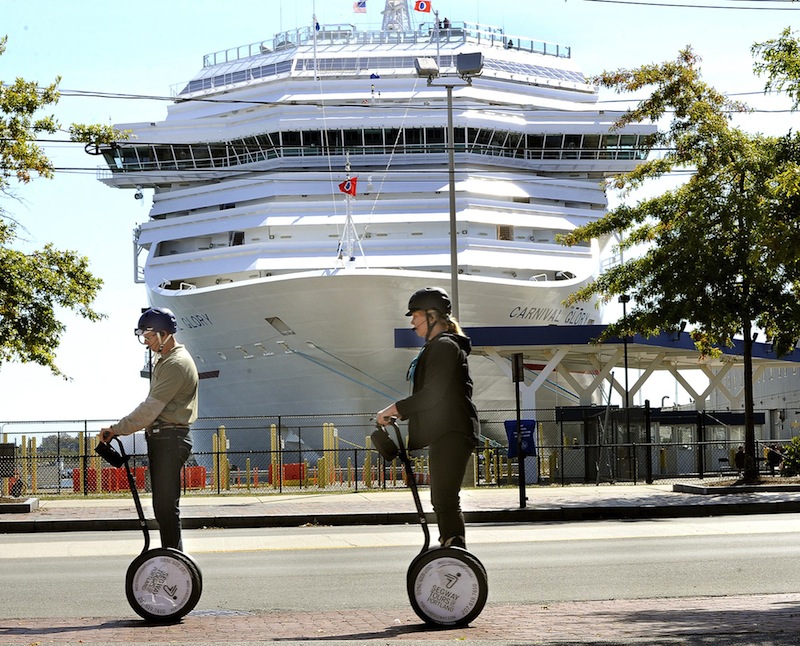A cruise line that calls on Portland regularly will fit many of its ships with new controls to reduce air emissions, under a tentative agreement with U.S. and Canadian regulators.
Thirty-two ships in the North American branch of Carnival Cruise Lines – the world’s largest cruise line – will be equipped with new exhaust-gas cleaning systems, said Roger Frizzell, senior vice president of corporate communications for the company.
Frizzell said the company hasn’t determined yet whether the new technology will be installed on ships that now visit Portland. Carnival will bring eight cruises to the port this year. Five are scheduled in September and October.
Carnival’s full fleet of vessels carries 6.5 million cruise passengers a year, Frizzell said.
Carnival plans to install the controls as part of an agreement with the Environmental Protection Agency, the Coast Guard and Transport Canada, to comply with air pollution reduction rules.
It is the most recent of several shipping companies, including cruise lines, that are taking steps to support development of advanced pollution-control technology particularly suited to maritime conditions.
The new emission controls, with technology derived from the power plant, manufacturing and auto industries, include sulfur oxide scrubbers and diesel particulate filters designed to eliminate some of the air pollution from the burning of fuel to power ships, Frizzell said. The two technologies have never before been combined for use on any marine vessel, he said.
The cost of the upgrades is expected to reach $180 million, about 10 percent of Carnival’s yearly fuel costs, Frizzell said.
But, with a fleet of 102 ships worldwide, the company anticipates that the new equipment, once fully developed and deployed, will produce “considerable savings,” he said, because it will enable the ships to avoid burning a more costly type of fuel to limit emissions.
Carnival Corp. is the world’s largest cruise company, with brands that operate in the waters of North America, Europe, Australia and Asia. The company has seven new ships scheduled to be delivered by April 2016.
The Carnival brands that sail regularly in what regulators call the North American Emission Control Area include Carnival Cruise Lines, Holland America Line, Princess Cruises and Cunard.
The emission control area forms a buffer zone around the U.S. and Canadian coasts. Under federal law, vessels in those areas must reduce harmful air pollution emissions and comply with stricter regulatory requirements on sulphur oxide, nitrogen oxide and particulate matter, according to EPA officials.
The areas were developed in 2012 by the United States and Canada through an agreement with the International Maritime Organization, the United Nations agency with responsibility for the safety and security of shipping and the prevention of marine pollution by ships.
The zones are meant to protect human health and the environment by substantially reducing air pollution from ocean-going vessels.
EPA officials said that with the new emission controls, cruise lines’ pollution reduction likely will surpass the levels required by 2020.
“This is a significant accomplishment as well as an important milestone for our company,” said Carnival Corp. CEO Arnold Donald. “Working together with the EPA, U.S. Coast Guard and Transport Canada, we have developed a breakthrough solution for cleaner air that will set a new course in environmental protection for years to come.”
Environmental organizations have long been alarmed by the amount of pollution generated by large cruise ships and other vessels.
“The ships are really a big source of pollution,” said Emily Figdor, executive director of Environment Maine in Portland. “We’re very concerned about the air-quality impacts of cruise ships.”
She said she had not yet reviewed the specifics of Carnival’s agreement.
By 2020, the EPA limits are expected to reduce emissions of nitrogen oxides, a key ingredient in smog, by 320,000 tons; particulate matter (soot) by 90,000 tons; and sulfur oxide by 920,000 tons. Each year, the standard should prevent tens of thousands of premature deaths and relieve respiratory symptoms for nearly 5 million people, according to EPA estimates.
While this round of improvements will be limited to ships serving North America, Carnival hopes eventually to extend the upgrades to all ports it serves, Frizzell said.
The final selection of the Carnival ships that will get the new air emissions technology has not yet been made, Frizzell said.
North Cairn can be contacted at 791-6325 or at:
ncairn@pressherald.com
Send questions/comments to the editors.



Success. Please wait for the page to reload. If the page does not reload within 5 seconds, please refresh the page.
Enter your email and password to access comments.
Hi, to comment on stories you must . This profile is in addition to your subscription and website login.
Already have a commenting profile? .
Invalid username/password.
Please check your email to confirm and complete your registration.
Only subscribers are eligible to post comments. Please subscribe or login first for digital access. Here’s why.
Use the form below to reset your password. When you've submitted your account email, we will send an email with a reset code.